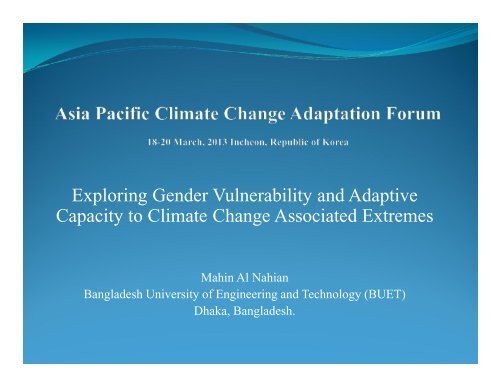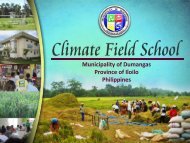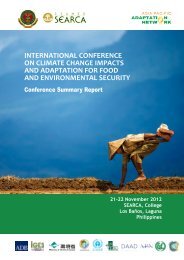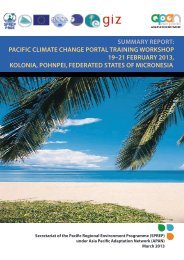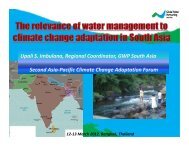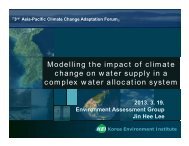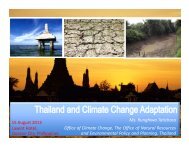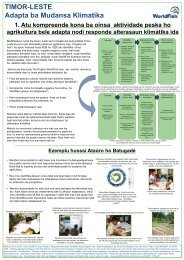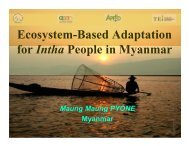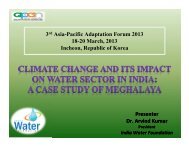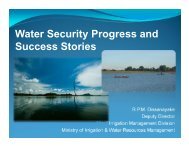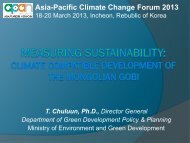Exploring Gender Vulnerability and Adaptive Capacity to Climate ...
Exploring Gender Vulnerability and Adaptive Capacity to Climate ...
Exploring Gender Vulnerability and Adaptive Capacity to Climate ...
- No tags were found...
Create successful ePaper yourself
Turn your PDF publications into a flip-book with our unique Google optimized e-Paper software.
<strong>Exploring</strong> <strong>Gender</strong> <strong>Vulnerability</strong> <strong>and</strong> <strong>Adaptive</strong><strong>Capacity</strong> <strong>to</strong> <strong>Climate</strong> Change Associated ExtremesMahin Al NahianBangladesh University of Engineering <strong>and</strong> Technology (BUET)Dhaka, Bangladesh.
Bangladesh: The context Bangladesh is the most vulnerable country in the world <strong>to</strong> tropicalcyclones <strong>and</strong> the sixth most vulnerable country <strong>to</strong> floods (UNDP, 2004). Bangladesh has been ranked as the 3rd most vulnerable in the world <strong>to</strong>sea level rise in terms of the number of people (McGranahan et al, 2006) Bangladesh as the country most vulnerable <strong>to</strong> extreme weather events<strong>and</strong> the one most affected in the period of 1990-2009 (GermanWatch,CRI, 2011). During 1991-2000 93 large scale natural disaster Total kill0.2 million people <strong>and</strong> property loss 59 billion dollar (onlyconsidering agricultural <strong>and</strong> infrastructure sec<strong>to</strong>r). If minimum death <strong>to</strong>lls over 5000 are considered, Bangladesh st<strong>and</strong>s asthe worst sufferer of all cyclonic casualties in the world, with a death<strong>to</strong>ll of about 53% of the global <strong>to</strong>tal(Ali, 1991). Bangladesh is one of the country most susceptible <strong>to</strong> negative impacts ofclimate change (IPCC).
The Problem statement <strong>Climate</strong> change, associated impact <strong>and</strong> vulnerability is gender neutral <strong>and</strong> men<strong>and</strong> women experience climate variability <strong>and</strong> change differently. Women his<strong>to</strong>rically having less access <strong>to</strong> the education, employment,property, food, health care, etc. will likely <strong>to</strong> suffer more than men frompoverty, hunger, malnutrition, economic crisis, environmental degradation,health related problems, insecurity <strong>and</strong> became victim of violence <strong>and</strong>political crisis in the backdrop of climate change. <strong>Climate</strong> change will magnify existing inequalities, reinforcing the disparitybetween women <strong>and</strong> men in their vulnerability <strong>to</strong> <strong>and</strong> capability <strong>to</strong> cope withclimate change (UNDP, 2007). The traditional approach in vulnerability assessment have its own limitation <strong>to</strong>capture the impact <strong>and</strong> associated vulnerability of climate change consideringthe overall gender dimension which might hamper formulation of ‘Equitable’adaptation <strong>and</strong> mitigation policy. Failure <strong>to</strong> acknowledge the genderdimension of climate change induced vulnerability will increase negligence<strong>and</strong> reduced participation in climate change adaptation that could collapse thebasic structure of society where the impact would spread out nationally <strong>and</strong>globally.
Objective of the studyThis study is an initiative <strong>to</strong> access the gender dimension ofclimate change associated vulnerability <strong>and</strong> adaptivecapacity~considering women not only the victim in change butrather <strong>and</strong> agent of change.<strong>Vulnerability</strong> had been accessed from two different dimension:1.<strong>Vulnerability</strong> of natural resource (from user perspective)2.<strong>Vulnerability</strong> of targeted community - women Explore adaptation <strong>and</strong> mitigation option from genderdimension.Provide suggestion in line <strong>to</strong> gender just climate changeadaptation <strong>and</strong> mitigation strategy <strong>and</strong> policy formulation.
Objective <strong>and</strong> Methodology Gabura union of Shyamnagar Subdistric<strong>to</strong>f Satkhira District hadbeen used as study area. The mostseverely affected cyclone Ailaunion is highly vulnerable <strong>to</strong> sealevel rise, cyclone <strong>and</strong> s<strong>to</strong>rm surge<strong>and</strong> tidal surge along with increasedsalinity ingestion <strong>and</strong> prolongedwater logging events. Questionnaire survey, Focus GroupDiscussion (FGD) <strong>and</strong> KeyInformant Interview (KII) had beenused for data collection. <strong>Vulnerability</strong> Assessment throughdeveloped Matrix framework. Statistical downscaling for scenariogeneration <strong>and</strong> future needassessment.
Perception regarding climate change All of the survey respondents confirmed “noticed change in climate”.The changes notices are: Increased temperature in summer Increased intensity <strong>and</strong> frequency of cyclone <strong>and</strong> s<strong>to</strong>rm surge Increasing trend in salinity intrusion Increased height of tidal wave due Sea level rise Erratic nature of rainfall Increased river bank erosion More water logged areas Long duration summer Monson with heavier rainfall No rainfall in Dry season Short duration monsoon No/less rainfall in Pre-Post monsoon More areas become prone <strong>to</strong> drought
<strong>Climate</strong> change <strong>and</strong> water resourceDirect impact of climate changeon water resource Change in rainfall pattern Salinity intrusion Change in wateravailabilityMajor sec<strong>to</strong>rs/ activity most sensitive <strong>to</strong>water stress related vulnerability Impact on water dependent ecosystem Impact on drinking water supply Cultivation Women’s home stead vegetablegardening Rearing of lives<strong>to</strong>ck <strong>and</strong> poultry Shrimp culture Impact on water quality Fishing Impact on Domestic water use St<strong>and</strong>ard of living Impact on underground water recharge Impact on In stream water dem<strong>and</strong> Navigation
Women <strong>and</strong> Water
Major Coping strategy/ activity due <strong>to</strong> the impact ofclimate change on water resourcesRain water harvesting & utilization as alternative sourcePond-river water is used for bathing purpose in lieu of salinityPond water is used for cleaning utensils <strong>and</strong> washing purposeMore distance need <strong>to</strong> be travelled for water collectionS<strong>to</strong>pped homestead vegetable gardeningYoung children sent for water collection, hampers schoolgoingPurchase drinking waterWater collection requires more visitDecrease water use in sanitation purposeChange of occupation
Possible Adaptation measure <strong>to</strong> reduce impact of climatechange on water resourcesIncrease the height of embankmentPlantation of saline <strong>to</strong>lerant tree speciesRWH <strong>and</strong> utilization in domestic activityReduce shrimp cultivationDigging of protected pond <strong>and</strong> PSF installationImproved drainage system installationChange in traditional irrigation practice
Impact of climate change on Productive role(livelihood activity) Agriculture Agricultural labor Non-agric daily labor Homestead vegetable gardening Shopkeeper/ selling in bazaar Cattle rearing <strong>and</strong> selling milk Fishing Poultry rearing Sewing Forest resource extraction Labor in shrimp farm/fish culture Shrimp fry collection
Impact of climate change on Re-productive role <strong>and</strong>Community management roleImpact on Re-productive role Water collection Fuel wood collection Cooking food Washing <strong>and</strong> cleaning Control of water use Caring of HH members Cattle rearing Homestead vegetable gardening FishingImpact on communitymanagement role Attend funeral, wedding, culturalevents Participation in VDC <strong>and</strong> WMCmeeting Participation in training related <strong>to</strong>water <strong>and</strong> sanitation management Participation in NGO/development related activity
Impact of climate change on access <strong>and</strong> control overresources <strong>and</strong> benefitImpact on access <strong>and</strong> control overresources Residential l<strong>and</strong> tenure Housing tenure Agricultural l<strong>and</strong> tenure Productivity of agricultural l<strong>and</strong> Improved sanitation facility Lives<strong>to</strong>ck related infrastructure Crop production related facility & infrastructure Labor Capital Education <strong>and</strong> training Health services Embankment Irrigation facility Cyclone shelter Cyclone warning system Communication network MFI Organizations NGOs Forest resourcesImpact on access <strong>and</strong> control overbenefit Improved status of living Asset ownership Financial development Development initiative
<strong>Vulnerability</strong> <strong>to</strong> climate change associated events <strong>and</strong>extremes against St<strong>and</strong>ard of well being
<strong>Vulnerability</strong> of Water resources (from user perspective)
<strong>Vulnerability</strong> of targeted community – Women
Summarized findings from <strong>Vulnerability</strong> Assessment The vulnerability of the most precious natural resource- water is 1.90.The context specific vulnerability <strong>and</strong> <strong>to</strong>tal vulnerability is almostsame. However, considering specific vulnerability it could be seen that,water resource is more vulnerable <strong>to</strong> climate change associated naturaldisasters or climate extremes. The resource itself as well as usercommunity lack proper adaptation option or capacity <strong>to</strong> withst<strong>and</strong> thenegative impact of climate change extremes. The vulnerability of gender community is 2.83. however, significantgap exists between context specific vulnerability <strong>and</strong> <strong>to</strong>tal vulnerability.It could be seen that, women community are much vulnerable <strong>to</strong>climate change associated gradual changes. Due <strong>to</strong> the adaptivecapacity, community became quit resilient <strong>to</strong> withst<strong>and</strong> climate changeassociated extreme events. But, there is very low adaptive optionavailable <strong>to</strong> the gradually changing climate or climate change events. In the existing context, if any natural disaster occur, the resultant impactwill be catastrophic.
Need assessment in predicted future generated scenario.Future scenario was generated for the period of 2040-2069<strong>and</strong> 2070-2099 for A2 <strong>and</strong> A1B SRES scenario. However,though the trend is similar among both the scenario, but themagnitude of change is more severe for A2 scenario.Generated scenario show increasing trend in temperature <strong>and</strong>decreasing trend in rainfall over the study area. In the context of generated future scenario, large scalemigration could become the only alternative if not planned<strong>and</strong> timely adaptation activity carried out in the impacted area– as perceived by local community.Large scale migration could also be resulted in<strong>to</strong> increase inconflict which ultimately disrupt the overall equilibrium statein the country.
Major coping strategy found effectivePlinth raising of homestead/ homestead should be constructed onraised groundTree plantation around homestead. CourtyardIncome generation through diversified sources/ earning fromrehabilitation work/ all capable member active in incomegenerationKeep up savings/ loan takingSeasonal migration for income generation/ temporary migration <strong>to</strong>relatives /permanent migration <strong>to</strong> urban areasAwareness build-up program/ training on DRRPreserve dry food, water <strong>and</strong> c<strong>and</strong>leMakeshift housing one embankmentHomestead vegetable gardening/ poultry rearingRain water harvesting
Major adaptation/ mitigation strategy/activity perceived effectiveplantation of saline <strong>to</strong>lerant tree species/ preserve <strong>and</strong> increaseforest resource/ inauguration of rice cultivationIncrease the height of embankment/ construction of newembankment with increased height/ proper maintenance/protection with CC block/ tree plantation on both sides ofembankmentIncrease the height of road network/ construct paved raisedroadMore shelters need <strong>to</strong> be constructed/ at least one per village/S<strong>to</strong>p shrimp farmingS<strong>to</strong>p saline water intrusion <strong>and</strong> utilization/ drain out salinewater/ construct drainage networkInstall more water points <strong>and</strong> rain water harvesting systemCreate job opportunity in locality
Major suggestion <strong>to</strong> address implications experienced by women onlyin during <strong>and</strong> post disaster period Emergency doc<strong>to</strong>r <strong>and</strong> medicine facility/ provision of midwife <strong>and</strong>treatment for pregnant in shelters Emergency supply of food, water, dry cloth, etc Supply hygiene product with relief package/ supply locally practicedmaterials used for hygiene management Emergency res<strong>to</strong>ration of water points <strong>and</strong> sanitation facility Emergency res<strong>to</strong>ration of road <strong>and</strong> communication network <strong>and</strong>repairing of embankments Operationalize satellite clinic immediately with medicine support Credit support with no/ less interest Provide income generation through rehabilitation activity Emergency res<strong>to</strong>ration of peace <strong>and</strong> security in affected area especiallyfor women <strong>and</strong> children Proper burying of dead, dumping of dead animal Provide support <strong>to</strong> mentally stressed patients in the affected area
Suggestion <strong>to</strong> mobility related problem of women duringcyclone <strong>and</strong> s<strong>to</strong>rm surgeConstruct more cyclone shelter in close vicinity/ separate roomfor women in shelter/ ensure security of women in shelterSignal/ search light facility from shelter <strong>and</strong> road marking <strong>to</strong>denote way <strong>to</strong> shelterConstruction of improved raised paved road networkProvision of boat <strong>to</strong> shift women, sick, disable/ inbuilt provisionin community <strong>to</strong> move women <strong>and</strong> childrenTeach swimming & tree climbing <strong>to</strong> womenWomen should wear salwar kamiz as emergency dress/ providelife jacket <strong>to</strong> womenWarning should be given early for evacuation/Men should assist women in preparedness work/ men shouldassist women <strong>to</strong> move <strong>to</strong> safety
Suggestion <strong>to</strong> implications experienced by women only indue <strong>to</strong> water logging Provision of cooking in shelters/ construction of more shelters at least oneper village Emergency relief distribution Emergency draining of stagnant water/ construction of drainage network Increase the height of embankment Installation of more tubewells with raised platform Construct house in raised ground/ raise overall ground of the area Arrangement of boat for moving Provision creation for income generation/ Industrialization/ establishincome generation option for women even remain home Provision <strong>to</strong> provide doc<strong>to</strong>r <strong>and</strong> healthcare facility <strong>to</strong> HH even in waterlogged condition Provide support for skin & gynological problem Awareness creation on violence, insecurity against women/ strengthensecurity in areas especially for women
Suggestion <strong>to</strong> implications experienced by women only indue <strong>to</strong> salinity intrusionRaise the height of embankmentConstruct drainage networkS<strong>to</strong>p saline water intrusion & usageS<strong>to</strong>p shrimp farmingPlantation of saline <strong>to</strong>lerant tree speciesInstallation of more water pointsInstallation of rain water harvesting system <strong>and</strong> Pond S<strong>and</strong>FilterProvide free treatment <strong>to</strong> skin problem victim
Suggestion for the improvement of existing cyclonewarning systemExtensive miking from mosque by imam will be more effectiveWarning issued by authority sent <strong>to</strong> individual by mobile call ormessageMiking/ siren from shelterVolunteer team formed & managed in each villageUnion Council managing warning distributionTraining <strong>to</strong> interpret warning & respective responseWarning should give surge height, duration, inundation length, etcGiven <strong>to</strong> all areas, not just around shelterWarning should be given early for effective evacuationCyclone warning should be accurate
Suggestion for the improvement of existing cyclone shelterdesignProvision for emergency treatment & medicine facilityProvision of water, food & cooking facilitySeparate room & latrine facility for male & femaleStrengthen security, provision of electricity & light in each roomWide & raised pakka approach road with road markingMedia campaign on importance & training on usageRoom for pregnant & child with emergency healthcare facilityMust have capacity <strong>to</strong> accommodate target communityProvision of cattle home in ground floorPositioning is important <strong>to</strong> be readily accessibleRed warning & search light on shelter roofProvision <strong>to</strong> convert in<strong>to</strong> makeshift residency for long duration
<strong>Gender</strong> inclusion in national adaptation policy Currently Bangladesh is carrying its adaptation program based onBangladesh <strong>Climate</strong> Change Strategy <strong>and</strong> Action Plan (BCCSAP 2009)<strong>and</strong> National Adaptation Programme of Action (NAPA 2009). NAPA <strong>and</strong> BCCSAP mentioned about the increased vulnerability ofwomen <strong>and</strong> children however, the straightforward statement doesn’tdescribe precisely the gender implication of climate change variability<strong>and</strong> extremes. BCCSAP provide instruction on research on gender implication ofclimate change <strong>and</strong> how gender mainstreaming can be achieved in allaction under BCCSAP along with developing criteria <strong>and</strong> approach forgender inclusion in all intervention in line <strong>to</strong> climate change adaptationwhichis quite well coming. However, it also pose a threat that, thegender exclusive adaptation policies are under implementation <strong>and</strong> withongoing no <strong>to</strong> low level of participation <strong>and</strong> gender exclusiveprogramme implementation might increase the existing gender disparitywhich could finally resulted in<strong>to</strong> failure of overall intervened activity. NAPA policy is <strong>to</strong>tally gender exclusive which might further reduce theeffectiveness of implemented development activity in long run.
ConclusionWomen are critical ac<strong>to</strong>r of change <strong>and</strong> up-bringer offuture generation.Women’s possess indigenous knowledge of adaptation<strong>and</strong> mitigation based on locally available resource basethrough combined effort <strong>and</strong> environmentalmanagement.Women triple activity is very important in/ for thesociety which need <strong>to</strong> be acknowledged <strong>and</strong> reflected inadaptation policy.The success of climate change adaptation will only thenbecome justifiable when gender just formulated policywill lead way for equitable development intervention.
Thanks


